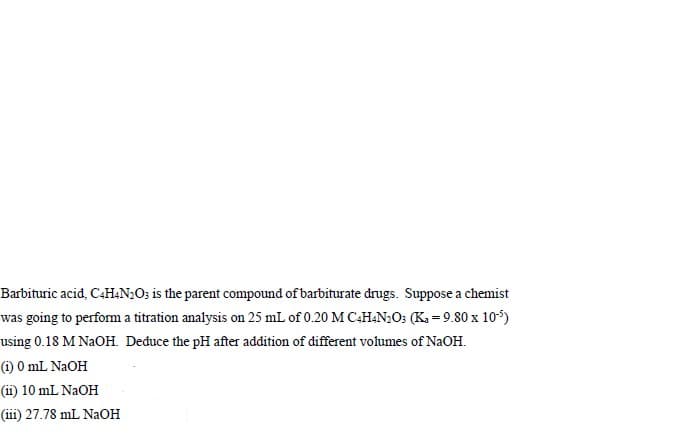Barbituric acid, C.H&N;O; is the parent compound of barbiturate drugs. Suppose a chemist was going to perform a titration analysis on 25 mL of 0.20 M CH&N;O; (K = 9.80 x 10) using 0.18 M NAOH. Deduce the pH after addition of different volumes of NaOH. ) 0 mL NaOH (11) 10 mL NaOH (iii) 27.78 mL NaOH
Barbituric acid, C.H&N;O; is the parent compound of barbiturate drugs. Suppose a chemist was going to perform a titration analysis on 25 mL of 0.20 M CH&N;O; (K = 9.80 x 10) using 0.18 M NAOH. Deduce the pH after addition of different volumes of NaOH. ) 0 mL NaOH (11) 10 mL NaOH (iii) 27.78 mL NaOH
Principles of Modern Chemistry
8th Edition
ISBN:9781305079113
Author:David W. Oxtoby, H. Pat Gillis, Laurie J. Butler
Publisher:David W. Oxtoby, H. Pat Gillis, Laurie J. Butler
Chapter15: Acid–base Equilibria
Section: Chapter Questions
Problem 49P
Related questions
Question
100%

Transcribed Image Text:Barbituric acid, C4HAN;O; is the parent compound of barbiturate drugs. Suppose a chemist
was going to perform a titration analysis on 25 mL of 0.20 M C4H&N;O; (K, = 9.80 x 105)
using 0.18 M NAOH. Deduce the pH after addition of different volumes of NaOH.
(1) 0 mL NAOH
(ii) 10 mL NAOH
(iii) 27.78 mL NAOH

Transcribed Image Text:Sodium acetate, NaCH;COO (82.0343 g/mol) is commonly used as acidic buffer solution.
Estimate the amount of NaCH;COO (in grams) to be mixed with 0.25 M acetic acid,
CH;COOH in order to produce a 500 mL buffer solution of pH 5.09. Given Ka of
CH;COOH is 1.8 x 105
Expert Solution
This question has been solved!
Explore an expertly crafted, step-by-step solution for a thorough understanding of key concepts.
Step by step
Solved in 4 steps

Knowledge Booster
Learn more about
Need a deep-dive on the concept behind this application? Look no further. Learn more about this topic, chemistry and related others by exploring similar questions and additional content below.Recommended textbooks for you

Principles of Modern Chemistry
Chemistry
ISBN:
9781305079113
Author:
David W. Oxtoby, H. Pat Gillis, Laurie J. Butler
Publisher:
Cengage Learning

Chemistry: Principles and Reactions
Chemistry
ISBN:
9781305079373
Author:
William L. Masterton, Cecile N. Hurley
Publisher:
Cengage Learning

Chemistry & Chemical Reactivity
Chemistry
ISBN:
9781133949640
Author:
John C. Kotz, Paul M. Treichel, John Townsend, David Treichel
Publisher:
Cengage Learning

Principles of Modern Chemistry
Chemistry
ISBN:
9781305079113
Author:
David W. Oxtoby, H. Pat Gillis, Laurie J. Butler
Publisher:
Cengage Learning

Chemistry: Principles and Reactions
Chemistry
ISBN:
9781305079373
Author:
William L. Masterton, Cecile N. Hurley
Publisher:
Cengage Learning

Chemistry & Chemical Reactivity
Chemistry
ISBN:
9781133949640
Author:
John C. Kotz, Paul M. Treichel, John Townsend, David Treichel
Publisher:
Cengage Learning

Chemistry & Chemical Reactivity
Chemistry
ISBN:
9781337399074
Author:
John C. Kotz, Paul M. Treichel, John Townsend, David Treichel
Publisher:
Cengage Learning

Chemistry: The Molecular Science
Chemistry
ISBN:
9781285199047
Author:
John W. Moore, Conrad L. Stanitski
Publisher:
Cengage Learning
